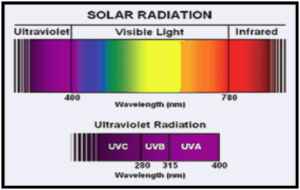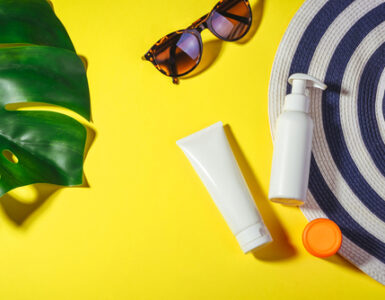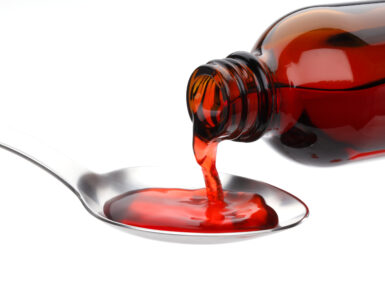By: ![]() Ronald W. Montgomery, B.S Van B. Nakagawara, O.D.
Ronald W. Montgomery, B.S Van B. Nakagawara, O.D.
Sunglasses help safeguard a pilot’s most important sensory asset – vision. A quality pair of sunglasses is essential n the cockpit environment to optimize ormance. Sunglasses reduce the effects of harsh sunlight, decrease eye fatigue, and protect ocular tissues from exposure to harmful solar radiation.  Additionally, they protect the pilot’s eyes from impact with objects (i.e., flying debris from a bird strike, sudden decompression, or aerobatic maneuvers). Sunglasses can also aid the dark adaptation process, which is delayed by prolonged exposure to bright sunlight.
Additionally, they protect the pilot’s eyes from impact with objects (i.e., flying debris from a bird strike, sudden decompression, or aerobatic maneuvers). Sunglasses can also aid the dark adaptation process, which is delayed by prolonged exposure to bright sunlight.
RADIATION. Radiation from the sun can damage skin and eyes when exposure is excessive or too intense. Fortunately, the Earth’s atmosphere shelters us from the more hazardous solar radiation (i.e., gamma and X-ray); however, both infrared (IR) and ultraviolet (UV) radiation are present in our environment in varying amounts. This is dependent upon factors such as the time of day and year, latitude, altitude, weather conditions, and the reflectivity of surrounding surfaces. For example, exposure to UV radiation increases by approximately 5 percent for every 1,000 feet of altitude.

Atmospheric IR energy consists of longwavelength radiation (780 – 1400 nanometers [nm], see Figure 1). The warmth felt from the sun is provided by IR radiation and is thought to be harmless to the skin and eyes at normal
atmospheric exposure levels. More hazardous to human tissues is short wavelength UV radiation. UV is divided into three bandwidths: UVA (400 –
315 nm), UVB (315 – 280 nm), and UVC (< 280 nm).1 Excessive or chronic exposure to UVA and, to a greater extent, UVB can cause sunburn, skin
cancers, and is implicated in the formation of cataracts, macular degeneration, and other eye maladies. The American Optometric Association recommends wearing sunglasses that incorporate 99 – 100% UVA and UVB protection.
Fortunately, UVC, the most harmful form of UV radiation, is absorbed by the atmosphere’s ozone layer before it reaches the Earth’s surface. Some scientists believe, however, that depletion of the ozone layer may allow more UV to pass through the atmosphere,2 making 100% UV protection a wise choice when selecting eyewear.
LENS MATERIAL. The three most common lens materials in use today are optical quality “crown” glass, monomer plastic (CR-39®), and polycarbonate plastic (see Table 1).

Lenses made from crown glass provide excellent optical properties (as indicated by the high Abbe value). Crown glass is more scratch resistant but heavier and less impact resistant than plastic. Glass absorbs some UV light; however, absorption is improved by adding certain chemicals during the manufacturing process or by applying a special coating. Glass retains tints best over time, but for higher refractive correction, the color may be less uniform, as parts of the lens will be thicker than others (see Figure 2).

CR-39® plastic lenses possess excellent optical qualities, are lighter in weight, and more impact resistant than glass lenses, but are more easily scratched, even when scratch-resistant coatings (SRC) are applied. CR-39® lenses tint easily and uniformly, even for those requiring a great deal of refractive correction, but do not hold tints as well as glass. CR-39® plastic can be bleached and retinted if fading becomes excessive at some point.
Polycarbonate plastic lenses are lighter than CR-39® and the most impact-resistant lenses available. Polycarbonates have a low Abbe value, indicating their inherent optical aberrations. The application of an anti-reflective (AR) coat can improve optical quality, particularly when a high refractive correction is required. These lenses have built-in UV protection and are manufactured with a scratch-resistant coating that is much stronger than that applied to CR-39® lenses.
Since polycarbonate lenses do not accept dye as CR-39® plastic, they are less adaptable for use as sunglasses. However, the interior anti-scratch coating will absorb tints.
High-index materials (i.e., index of refraction ≥ 1.60) are available in both glass and plastic for those who require a large degree of refractive correction and/or desire lighter, thinner lenses. High-index materials are not as widely available, require AR coats to improve optical clarity, and a SRC for durability. In addition, most high-index materials do not accept tints as easily and are less shatter resistant than low-index materials.
COATINGS. Special coatings can be applied to lens materials for reasons such as those previously mentioned. Crown glass and most plastic lenses require a specific coating to block residual UV radiation. Plastic and polycarbonate lenses require a SRC to prolong their useful life. The SRC applied to polycarbonate lenses absorb tints and dyes. High-index materials benefit from AR coatings to improve transmissivity due to their high reflective properties. While AR coats can improve optical clarity, they are extremely porous, attracting water and oils, making the lenses difficult to clean. Lenses with AR coatings should be “sealed” with a smudge- and water-repellant coat that extends the useful life of the AR coat and make the lenses easier to keep clean. Coatings must be applied correctly and lenses must be meticulously cleaned for the process to be successful. Coated lenses should be handled with care and not subjected to excessive heat to avoid delamination or crazing.
TINTS. The choice of tints for sunglasses is practically infinite. The three most common tints are gray, gray-green, and brown, any of which would be an excellent choice for the aviator. Gray (neutral density filter) is recommended because it distorts color the least. Some pilots, however, report that gray-green and brown tints enhance vividness and minimize scattered (blue and violet) light, thus enhancing contrast in hazy conditions. Yellow, amber, and orange (i.e., “Blue Blockers”) tints eliminate short-wavelength light from reaching the wearer’s eyes and reportedly sharpen vision, although no scientific studies support this claim.
In addition, these tints are known to distort colors, making it difficult to distinguish the color of navigation lights, signals,or color-coded maps and instrument displays. For flying, sunglass lenses should screen out only 70 – 85% of visible light and not appreciably distort color. Tints that block more than 85% of visible light are not recommended for flying due to the possibility of reduced visual acuity, resulting in difficulty seeing instruments and written material inside the cockpit.
POLARIZATION. Polarized lenses are not recommended for use in the aviation
environment. While useful for blocking reflected light from horizontal surfaces such as water or snow, polarization can reduce or eliminate the visibility of instruments that incorporate anti-glare filters. Polarized lenses may also interfere with visibility through an aircraft windscreen by enhancing striations in laminated materials and mask the sparkle of light that reflects off shiny surfaces such as another aircraft’s wing or windscreen, which can reduce the time a pilot has to react in a “see-and-avoid” traffic situation.
PHOTOCHROMIC. Glass photochromic lenses (PhotoGray® and PhotoBrown®), like their plastic counterpart (Transitions®), automatically darken when exposed to UV and become lighter in dim light. Most of the darkening takes place in the first 60 seconds, while lightening may take several minutes. Although most photochromic lenses can get as dark as regular sunglasses i.e., 20% light transmittance in direct sunlight, warm temperature (>70°F) can seriously limit their ability to darken, and reduced UV exposure in a cockpit can further limit their effectiveness. In addition, the faded state of photochromic glass lenses may not be clear enough to be useful when flying in cloud cover or at night.
FRAMES. The selection of sunglass frames is probably more a matter of personal preference than lens material or tint. The frames of an aviator’s sunglasses, however, must be functional and not interfere with communication headsets or protective breathing equipment. Frame styles that incorporate small lenses may not be practical, since they allow too much visible light and UV radiation to pass around the edges of the frame. A sunglass frame should be sturdy enough to take some abuse without breaking, yet light enough to be comfortable. An aviator’s sunglasses should fit well so that sudden head movements from turbulence or
aerobatic maneuvers do not displace them. Finally, use of a strap is recommended to prevent prescription sunglasses from being accidentally dislodged, or a necklace chain can be used to allow them to be briefly removed and subsequently replaced.
SUMMARY. While adding to the mystique of an aviator, sunglasses protect a pilot’s eyes from glare associated with bright sunlight and the harmful effects from exposure to solar radiation. Lenses for sunglasses that incorporate 100% UV protection are available in glass, plastic, and polycarbonate materials. Glass and CR-39® plastic lenses have superior optical qualities, while polycarbonate lenses are lighter and more impact resistant. The choice of tints for use in the aviation
environment should be limited to those that optimize visual performance while minimizing color distortion, such as a neutral gray tint with 15 – 30% light transmittance. Polarized sunglasses are not recommended because of their possible interaction with displays or other materials in the cockpit environment.
Since sunglasses are an important asset, whether or not refractive correction is required, careful consideration should be used when selecting an appropriate pair for flying.
Finally, the technology associated with ophthalmic lenses is continually evolving, with the introduction of new materials, designs, and manufacturing techniques.
Aviators should consult with their eye care practitioner for the most effective alternatives currently available when choosing a new pair of sunglasses.
_________________________________________________________________________________
Prepared by: FAA Civil Aerospace Medical Institute (CAMI), published with permission.
REFERENCES.
1. La Comission Internationale de l’Eclairage (CIE). Figures correspond broadly to the effects of UVR on biological tissue.
2. World Meteorological Organization. Scientific Assessment of Ozone Depletion: 1994, WMO Global Ozone Research and Monitoring Project – Report No. 37, Geneva, Switzerland:1995.
3. Rash CE, Manning SD. For Pilots, Sunglasses are Essential in Vision Protection. Flight Safety Foundation Human Factors & Aviation Medicine, July-August 2002; 49(4): 1-8.















